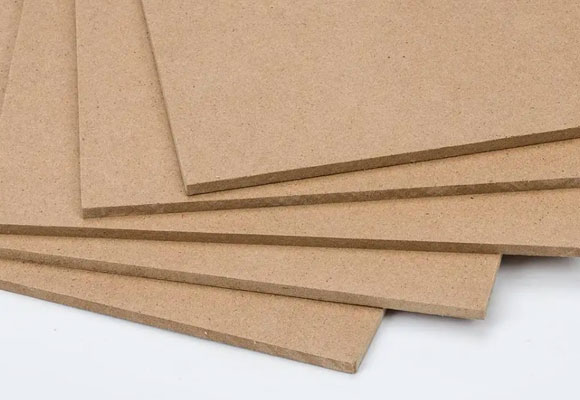
What Is MDF? A Complete Guide To MDF Board
When it comes to selecting wood furniture, you should consider a lot of factors, such as cost, quality, material, color, etc. Material may be the most important factor because it determines the durability of your furniture. There are many types of material, including solid wood, plywood, MDF, laminate, melamine, veneer, particle board, etc. Today, we’re going to introduce the MDF, aka medium-density fiberboard, which is more affordable and versatile than most other types of boards. Actually, it is not a wooden board, but what is it? What are the advantages and disadvantages of MDF boards? When should we choose MDF? Plywood, particle board, or MDF, which one is better? Let’s scroll down and find out the answers.

What Is MDF?
According to Wikipedia, a Medium-density fibreboard (MDF) is an engineered wood product made of wood residuals, which are primarily sawdust and shavings. These small pieces of wood are broken down into wood fibers in a defibrator. Once dehydrated, these wood fibers are combined with resin and wax to form panels. Then, apply high temperature and intense pressure to these panels to get them compressed. Finally, sand the panels for a nice and smooth finish. Generally, there are three types of MDF: Ultralight MDF, Moisture-resistant board, and Fire retardant MDF.
Advantages
- MDF is relatively more affordable and budget-friendly.
- MDF has an extremely smooth surface and is perfectly flat without knots or kinks.
- MDF possesses high density and hardness and is resistant to warping.
- Compared to solid wood, MDF expands and contracts less.
- Since MDF is made of small pieces of wood, tools for solid wood are also useful for MDF, such as saws, routers, and drills.
- MDF is an ideal substrate for veneer thanks to its perfect smoothness.
- MDF is easy to cut or drill without any splinters or tear-out.
- MDF is greatly compatible with solid wood in furniture making.
- Thanks to the extremely smooth and flat surface, MDF is perfect for painting.
- Glue can be used on MDF well.
- Due to the chemicals used in the manufacturing process, MDF is protected from insects.
Drawbacks
- MDF contains urea-formaldehyde, a nontransparent thermosetting resin or polymer that is a suspected carcinogen. Cutting and sanding MDF outside is highly recommended. Plus, you’d better wear a respirator.
- Cutting MDF can create lots of dust, so wearing a mask is quite necessary.
- MDF is denser than plywood, so it is very heavy, making it difficult to carry and work with if there are no co-workers.
- MDF can soak water quickly when the edges are exposed, causing swelling.
- Since MDF is made of little pieces of wood, it can’t hold nails or screws well.
- MDF doesn’t have wood grain, so if it is stained, the finish will be horrible.
- Compared to real wood, MDF is less solid and can easily break under great pressure.
- MDF can dull blades more quickly than solid wood. Tungsten carbide tipped saw blades are recommended.
Applications Of MDF
Read on to discover the most common applications of MDF boards.
- Furniture
Furniture made of MDF boards is more economical than those made of real wood. With a limited budget, MDF furniture such as a bookshelf is a good choice.
Besides, most cabinets in kitchens are also made from MDF.
- Fireproofing, Vaporproofing, Soundproofing
Thanks to its chemical makeup, MDF is fireproof, vapor-proof, and soundproof. Therefore, MDF is often used in many commercial and residential buildings. The phenol-formaldehyde resin in MDF allows it to resist fire. With resistance to moisture, MDF boards can reduce home electricity consumption. Many sound speaker production companies utilize MDF due to the requirement for sound insulation.
- Roofing
Because MDF is resistant to severe weather, it is often used in roofing systems.
MDF vs. Solid Wood

Solid wood furniture is favored by many people. It’s durable and strong and has beautiful wood grain. It represents the charm of nature. The beauty of real wood is unrivaled. However, compared to MDF, solid wood has its disadvantages. Solid wood expands or contracts with temperature changes, thus causing cracks over time. Bug infestation is another problem of solid wood. Certain daily maintenance is needed if you buy wood furniture. While MDF boards don’t have those issues as we mentioned above.
MDF vs. Plywood

Plywood consists of layers of wood, usually from three to nine. Plywood with more layers features higher strength and durability. Unlike MDF, plywood has wood grains and can be curved when necessary. Plywood is less dense than MDF and is more expensive than MDF.
Which Is Right For You?
When you are wavering between MDF and other materials, there are many factors to consider, such as cost, style, features, colors, quality, lifespan, etc. Before making a decision, doing enough research is quite important. Of course, our article may help to some extent, but there is always more information you should get. We believe that you can make the right choice at last!